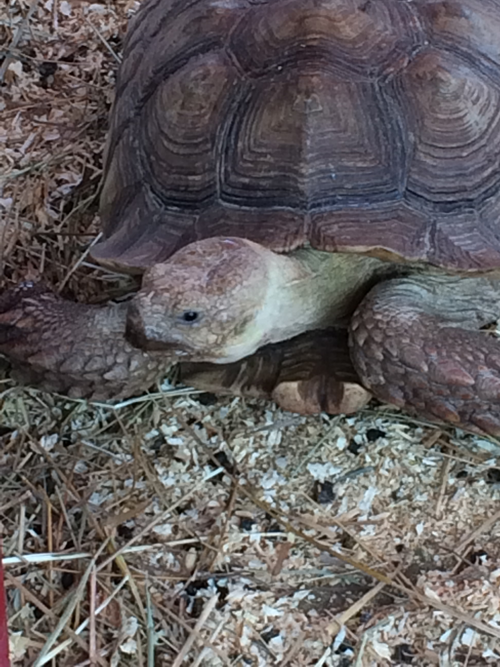Desert Tortoises

⇐ Back To All Turtles
Desert Tortoise Care Guide
Habitat
Enclosure: Provide a spacious outdoor enclosure with secure walls at least 18 inches high and 12 inches deep to prevent escape. The enclosure should offer both sunny and shaded areas. For indoor enclosures, a large terrarium or tortoise table is suitable, ensuring ample space for the tortoise to move around. A 10.0 UVB light is a must and it should be changed every 6 months.
Substrate (indoors): Use reptile carpet or tile for easy cleaning and to prevent ingestion of loose substrate.
Shelter: Include a burrow or hide to protect from extreme temperatures and predators. The burrow should mimic natural conditions, being cool and humid.
Tortoise Table for Hatchlings: Use a tortoise table for hatchlings to ensure their safety. A tortoise table provides a controlled environment that protects young tortoises from predators and prevents them from escaping.
Temperature and Humidity
Outdoor Enclosures:
Daytime Temperature: Maintain a temperature range of 85-95°F (29-35°C) in the basking area. The cooler end of the enclosure should be around 70-75°F (21-24°C).
Nighttime Temperature: Should not drop below 50°F (10°C).
Indoor Enclosures: A temperature gradient is important.
Basking Area: Provide a basking area with a temperature range of 85-95°F (29-35°C).
Low Temperature: Maintain low end temperature of 70-75°F (21-24°C)
Nighttime Temperature: Should not drop below 60°F (16°C).
Humidity: Desert tortoises require low humidity. Ensure the enclosure is well-ventilated.
Lighting
Outdoor Enclosures: Ensure they receive natural sunlight, which is essential for their health.
Indoor Enclosures: Provide 10.0 UVB lighting for 10-12 hours a day to mimic natural sunlight and support vitamin D3 synthesis.
Diet
Primary Diet: Feed a variety of high-fiber, low-protein, and calcium-rich foods. Suitable options include:
Grasses and hay as well as tortoise pellets.
Leafy greens (e.g., collard greens, dandelion greens, mustard greens). We recommend spring green mix.
Vegetables (e.g., squash, bell peppers, carrots) - various colors.
Occasional Fruits: Offer small amounts of fruits like berries, apples, and melons sparingly.
Supplements: Provide calcium supplements for young and growing tortoises.
Water
Hydration: Provide a shallow water dish for drinking and soaking. Change the water daily to keep it clean.
Soaking: Allow the tortoise to soak in shallow, lukewarm water for 15-30 minutes once a week to stay hydrated.
Health and Wellness
Regular Check-ups: Schedule regular veterinary check-ups to monitor health.
Parasite Control: Regularly check for parasites and seek veterinary treatment if needed.
Shell Health: Inspect the shell regularly for any signs of damage or infection.
Dog: dog bite trauma to tortoises is common
Common Medical Problems
Respiratory Infections: Symptoms include nasal discharge, labored breathing, and lethargy. Ensure proper temperature and humidity levels and seek veterinary care if symptoms arise.
Shell Rot: Caused by bacterial or fungal infections, often due to poor living conditions. Maintain a clean habitat and consult a vet if you notice soft spots or discoloration on the shell.
Metabolic Bone Disease (MBD): Caused by a lack of calcium or improper UVB lighting. Prevent with a proper diet and adequate UVB exposure. Signs include soft or deformed shell and limbs.
Parasites: Regularly check for external parasites like ticks and mites, and internal parasites that can cause weight loss and lethargy. Consult a vet for diagnosis and treatment.
Dehydration: Ensure access to fresh water and regular soaking. Signs include sunken eyes and dry skin.
Trauma - from dogs
Hibernation (is not required)
Preparation: In late fall, reduce feeding and gradually lower the temperature to prepare for hibernation.
Hibernation Box: Provide a hibernation box filled with soft substrate like soil or sand.
Temperature Control: Keep the hibernation area between 40-50°F (4-10°C).
Soak once weekly while hibernating
Monitoring: Check the tortoise periodically to ensure it is healthy and the temperature remains stable.
Enrichment and Interaction
Enrichment: Provide rocks, logs, and tunnels to explore.
Handling: Minimize handling to reduce stress. When necessary, handle gently and support their entire body.
Legal and Ethical Considerations
Wild Tortoises: Never take a desert tortoise from the wild or release a pet tortoise into the wild. Doing so can harm the local ecosystem and the tortoise itself.
Conservation: Be aware of conservation efforts and support local initiatives to protect wild desert tortoises.
For more information, visit Little Critters Veterinary Hospital for comprehensive care guides and support.
|